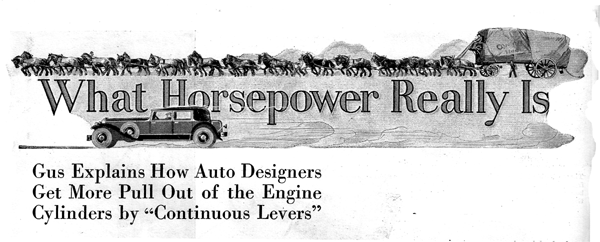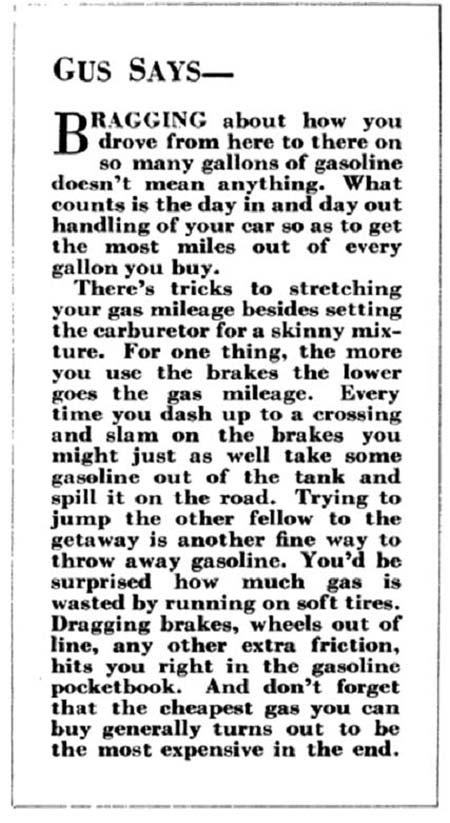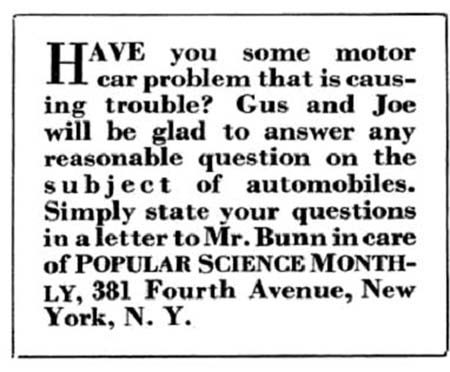February 1930
Gus Explains...
by Martin Bunn

"One hundred horsepower!" Joe Clark whistled to himself as he read the specifications of one of the new cars.
Gus Wilson, veteran auto mechanic and Joe's partner in the operation of the Model Garage, merely grunted. His mouth was too full of ham sandwich for articulate expression.
"One hundred horsepower!" Joe repeated. "That's a whale of a lot of power to be controlled by a dinky little pedal under the toe of your shoe. It's equal to fifty pairs of horses. Think of an auto able to pull as strong as that many horses!"
"Why think of it when it isn't so?" Gus growled as he fished a vacuum bottle from his lunch kit. "Fifty pairs of horses could drag any auto ever made all over the lot."
"But I thought you told me gasoline engine horsepower was the same as real horsepower," Joe protested.
"I did," admitted Gus. "A one-horse-power gasoline motor, if you applied its power just right, could lift 33,000 pounds one foot every minute all day long. It'd take a pretty husky 'oat motor' to equal that."
"Then," Joe mused, instinctively reaching for a pencil, "a hundred-horse-power motor ought to be able to pull 3,300.000 pounds. Gosh! That's more pull than a big politician has."
"That's right," Gus smiled. "Figures don't lie, but sometimes they don't mean anything, either. You could get that much pull out of a one-horsepower motor just as easy if you geared it right. Trouble with you and a lot of other folks is you don't know what horsepower really means."
"You said a one-horse engine could lift 33,000 pounds," Joe argued. "If that's the bunk, then just what is a horsepower anyway?"
"You forgot I said it could lift that much weight a foot in a minute," replied Gus. "How long it takes and how far the weight is lifted are just as important as the weight itself. That's what horse-power is -- a sort of combination measure of the work done and the time it takes to do it. It doesn't make any difference whether you lift 33,000 pounds one foot in a minute or twice that weight half the distance in the same time. It still needs one horsepower to do the job. But if you tried to yank 33,000-pound weight up two feet in a minute you'd need two horsepower. Or if you could take two minutes to move it up a foot you'd get by with only half a horsepower."
"Now I'm beginning to understand," said Joe. "The pull or weight-lifting power isn't a measure of horsepower at all."
"Not if you take it just by itself," Gus explained. "A long time ago there was a bird named Archimedes who got a lot of notoriety by claiming he could move the world if somebody'd give him a long enough lever and a place to stand. Nobody could call the old ducks bluff and he knew it, but he had the right dope just the same. If you could go sailing out into space with a nice long lever, hook the end of it under the earth, and rest it against any other planet that happened to be handy, and you had some way to get a toe-hold on the ether that's supposed to fill space, you could move this earth right out of its orbit -- provided the lever didn't bust. Old Archimedes wasn't particularly interested in moving the earth anyhow -- all he wanted was a sensational way to explain how a crowbar works."
"What's that got to do with horsepower of an auto motor?" asked Joe.
"A whole lot," Gus answered. "A crowbar is nothing but a lever that fits the kind of power you have to the job that has to be done. You can, for instance, push with a force of one pound on the end of a lever and move it a distance of one foot. With the right fulcrum -- which is the point where the lever braces against something solid -- you can lift a weight of twelve pounds a distance of one inch. Or you could move the fulcrum nearer the weight and find a point where you could lift twenty-four pounds a half inch. An automobile is just full of levers, only most of 'em aren't like crowbars. They're gears, and gears really are continuous levers."
"Still I don't see the connection between gears and horsepower," Joe objected again.
"You will in a minute," Gus continued. "A gasoline motor is a lot like a human being in some respects. With a lever you can lift a heavy weight that you couldn't budge if you grabbed hold of it direct. The gasoline motor turns the crank shaft with only so much turning force -- called torque. So the motor is speeded up and by means of gears this fast, not-so-strong motion is turned into a slower movement with a lot of pull to it."
"Then it's the gears that determine the pull, and the horsepower hasn't anything to do with it?" Joe interrupted.
"If you're talking about just plain pull, that's right. By using extra low gearing you could drive a five-ton truck, fully loaded, up the side of a steep mountain with a one-horsepower motor. Of course it would barely crawl along -- you'd have sacrificed speed to get the necessary pull."
"But couldn't you speed the motor to beat the band to make up for that?" Joe suggested.
"Now you're getting into some of the ins and outs of engine design," smiled Gus. "That's what the engineers have been doing ever since the first gasoline engine was built. Instead of making bigger and bigger cylinders to get more power, they have let the cylinder size alone and obtained more power out of the same set or cylinders by making 'em work faster. Bigger valves, larger gas passages, higher compression, lighter moving parts, better balance have all been used to let the motor turn over faster and still develop the same turning force or torque. If you did all those things to the one-horsepower motor in the five-ton truck we were talking about, you'd make it go up the hill faster all right because the motor wouldn't be a one-horse motor any longer. Maybe it would be as much as two horsepower. Lots of auto motors rated at ninety to a hundred horsepower today have no bigger cylinders than the forty- and fifty-horsepower cars of years ago."
"I suppose that's why they rate gasoline motors at a certain horsepower at so many revolutions a minute," observed Joe. "Do those ratings tell how fast the motor will run?"
"Not at all," Gus explained. "All motors will turn over faster than the rate at which they develop the most horsepower. Only, when the motor speeds up beyond that point, the turning force drops off so fast that the horsepower goes down. It's like running a foot race. You get going about so fast and when you try to go any faster the muscles in your legs won't put any push into your feet."
"Then that explains why different cars have different gear ratios," Joe commented. "Each one has a gear ratio that will let the motor run at the speed where it will develop the most amount of power."
"That's how they ought to be geared," said Gus. "Actually they're not. It's a sort of a compromise in most cases. Most everybody wants to be able to climb the side of a house in high gear and pull through the toughest kind of going without shifting. You can't have your cake and eat it, too, Joe, so if cars have to be made for people too lazy to shift gears, the manufacturers have to gear 'em lower than the best point for smooth easy running, maximum speed, and best gasoline economy on level roads."
"Maybe that's why some of the cars are fitting four-speed transmissions," Joe suggested.
"Sure, but if a driver is too lazy to shift a three-speed transmission, putting four speeds in the box isn't going to cure him," Gus grumbled. "A real four-speed transmission would be ideal, but the ones they're fitting now are geared so low on high they really amount to a three-speed outfit with first speed reduced to an extra low gear that isn't any use."
"Wouldn't that extra low first, if you had it in a hundred-horsepower car, make it pull like fifty pairs of horses?" Joe asked again picking up the specifications of the car that had started the discussion.
"It might if it were low enough and you loaded the car with pig lead to give it traction," said Gus, sweeping the crumbs off the table into his lunch kit. "No matter how much power you've got or what the gear ration is, you can get only so much pull before the back wheels of the car begin to slip. It sure would take a lot of weight to make two rubber tires grab the road like four hundred horseshoes!"
END
L. Osbone 2019

